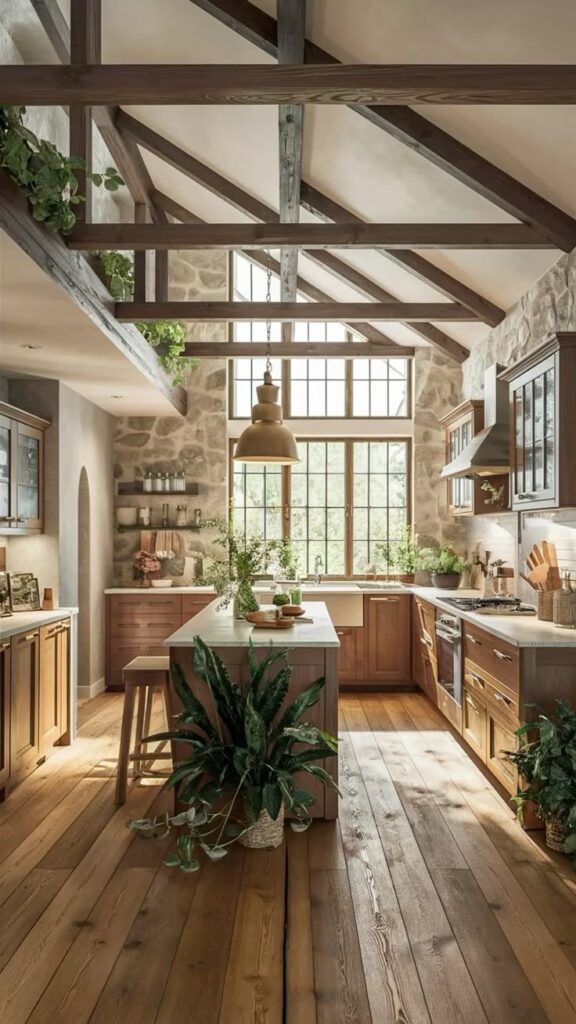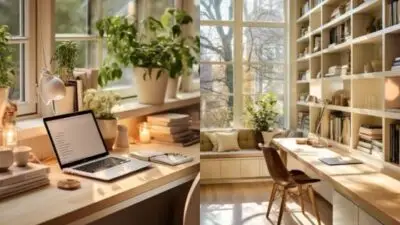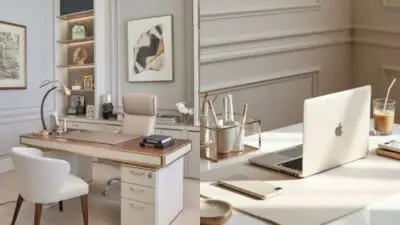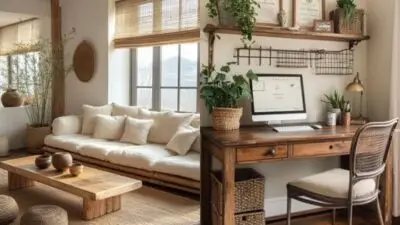As our awareness of environmental issues grows, eco-friendly interior design has evolved from a niche trend to a mainstream movement. This holistic approach to creating living spaces focuses on minimizing negative environmental impacts while promoting healthier indoor environments. Sustainable interior design prioritizes non-toxic, low VOC materials that significantly reduce harmful effects on both your health and the planet.
Working with what you already have is at the core of eco-conscious design philosophy. Rather than discarding furniture and décor to chase fleeting trends, sustainable designers find creative ways to repurpose, upcycle, and transform existing pieces. This mindful approach not only reduces waste but often results in more personalized, unique spaces that tell your story through thoughtfully curated elements.
Key Takeaways
- Choosing non-toxic, low VOC materials creates healthier living spaces while reducing environmental impact.
- Repurposing existing furniture and décor is more sustainable than replacing items based on changing trends.
- Eco-friendly design balances environmental responsibility with aesthetic appeal and functional comfort for your home.


Essentials of Eco-Friendly Interior Design
Sustainable interior design prioritizes environmental responsibility while creating beautiful, functional spaces. The core elements focus on reducing environmental impact, implementing thoughtful design principles, and enhancing occupant health through improved indoor conditions.
Defining Sustainable Design Principles
Sustainable design is a holistic approach that minimizes negative environmental impacts through thoughtful choices. You can incorporate this philosophy by selecting materials with low environmental footprints such as bamboo, cork, reclaimed wood, and recycled content products.
When shopping for furniture and decor, look for items with certifications like FSC (Forest Stewardship Council) or Greenguard. These ensure materials meet specific environmental and health standards.
Consider the entire lifecycle of products—from raw material extraction to manufacturing, transportation, use, and eventual disposal. Choose items designed for durability and longevity rather than following temporary trends.
Local sourcing is another key principle. By purchasing locally-made products, you reduce transportation emissions while supporting regional economies and craftspeople.
Importance of Environmental Impact
Every design choice you make has environmental consequences that extend beyond your home. Energy efficiency forms the foundation of eco-friendly interiors through proper insulation, energy-efficient appliances, and smart home systems that optimize resource use.
Water conservation should factor into your decisions through low-flow fixtures and water-efficient appliances. These simple changes can dramatically reduce your household’s water footprint.
Waste reduction strategies are essential components of sustainable design. Repurpose existing furniture through refinishing or reupholstering rather than replacing items. When renovating, carefully deconstruct rather than demolish to salvage usable materials.
Consider the chemical composition of products you bring into your home. Many conventional paints, adhesives, and finishes contain volatile organic compounds (VOCs) that can harm both the environment and human health.
The Role of Natural Light and Indoor Air Quality
Natural light does more than create beautiful spaces—it reduces electricity consumption and positively impacts your physical and mental wellbeing. Position furniture to maximize daylight penetration and use reflective surfaces to bounce light deeper into rooms.
Strategic window treatments help manage heat gain and loss. Consider programmable blinds or thermal curtains that can be adjusted throughout the day based on sun position and seasonal needs.
Indoor air quality significantly affects your health, as most people spend approximately 90% of their time indoors. Integrate air-purifying plants like snake plants, spider plants, and peace lilies to naturally filter airborne toxins.
Choose low-VOC or zero-VOC paints, adhesives, and finishes to minimize harmful emissions. Proper ventilation systems are equally important—consider heat recovery ventilators that exchange stale indoor air with fresh outdoor air while preserving temperature control.


Materials for a Sustainable Future
The choice of materials significantly impacts the environmental footprint of interior design projects. Sustainable options have expanded dramatically in recent years, offering both aesthetic appeal and ecological benefits.
Choosing Sustainable and Recycled Materials
Sustainable materials form the foundation of eco-friendly interior design. These include products made from renewable resources, recycled content, or those manufactured with minimal environmental impact. Recycled plastics have evolved considerably, now appearing in everything from countertops to decorative elements with sophisticated finishes.
Stone wool panels represent an innovative option as they’re produced from 100% natural stone and contain no plastic or irritating substances. These materials provide exceptional durability while maintaining environmental integrity.
When selecting materials, look for certifications that validate sustainability claims. Third-party verifications like FSC (Forest Stewardship Council) for wood products or Cradle to Cradle certification ensure your choices meet rigorous environmental standards.
Consider the full lifecycle of materials – from extraction and manufacturing to eventual disposal or recycling potential. Locally sourced options reduce transportation emissions and support regional economies.
Benefits of Using Bamboo and Reclaimed Wood
Bamboo stands out as an exceptional sustainable choice due to its rapid growth cycle – reaching maturity in just 3-5 years compared to decades for hardwoods. This fast-renewing grass absorbs carbon dioxide efficiently during growth and releases 35% more oxygen than equivalent trees.
Reclaimed wood gives new life to existing materials, preventing further deforestation. Sources include old barns, factories, warehouses, and even wine barrels, each bringing unique character and history to your space.
Benefits extend beyond environmental considerations:
- Durability: Both bamboo and properly treated reclaimed wood offer excellent longevity
- Aesthetic value: Natural variations in color and texture create visual interest
- Health benefits: Lower VOC emissions compared to many manufactured materials
These materials work beautifully in flooring, furniture, wall paneling, and decorative accents, providing versatility across design styles.


Reducing Resource Depletion with Natural Fibres
Natural fibres provide sustainable alternatives to synthetic options that rely on petroleum products. Organic cotton, hemp, and linen stand out for their durability and resistance to regular wear, extending the lifecycle of textile products in your home.
These materials require significantly fewer chemical inputs during production. Hemp, in particular, grows rapidly without pesticides and improves soil health through phytoremediation.
Consider these applications for natural fibres:
- Window treatments
- Upholstery
- Floor coverings
- Wall coverings
- Bedding and accessories
Wool offers exceptional natural insulation properties, reducing energy needs while providing comfort. It’s naturally flame-resistant without chemical treatments and absorbs indoor air pollutants, improving air quality.
When selecting textiles, look for organic certifications that ensure sustainable farming practices. GOTS (Global Organic Textile Standard) certification verifies environmental and social responsibility throughout production.


Energy Efficiency and Saving Strategies
Energy-efficient interior design significantly reduces both environmental impact and operating costs. The right strategies can transform a space from an energy drain to a model of sustainability while maintaining comfort and functionality.
Maximizing Energy Savings with Smart Tech
Smart thermostats represent one of the most impactful energy-saving investments for your home. These devices learn your schedule and preferences, automatically adjusting temperatures to reduce unnecessary heating and cooling when you’re away or asleep. Many models offer smartphone control, allowing you to monitor and adjust your home’s temperature remotely.
Smart power strips eliminate phantom energy draw from electronics, cutting up to 10% from your electricity bill. These devices detect when appliances are in standby mode and cut power completely.
Automated blinds and window treatments work with your HVAC system by blocking heat in summer and allowing solar gain in winter. This passive approach reduces your heating and cooling demands without sacrificing comfort.
Smart home hubs integrate these technologies, optimizing your home’s energy use based on real-time conditions and your personal preferences.
Innovations in Energy-Efficient Lighting
LED lighting technology has revolutionized energy-efficient design by consuming up to 75% less energy than traditional incandescent bulbs while lasting 25 times longer. The initial investment pays for itself quickly through reduced electricity costs.
Daylight harvesting systems use sensors to adjust artificial lighting based on available natural light. These systems maintain consistent illumination while minimizing unnecessary electricity usage during daylight hours.
Task lighting focuses light exactly where needed rather than illuminating entire spaces, reducing overall energy consumption while improving functionality. This approach works particularly well in kitchens, offices, and reading areas.
Smart lighting systems allow for precise control over brightness, color temperature, and timing. You can program lights to automatically adjust based on time of day, occupancy, or specific activities.
Long-Term Cost Savings of Green Choices
Energy-efficient windows with proper glazing and tight seals prevent thermal transfer, reducing your heating and cooling costs by 10-25% annually. This represents significant savings over the lifetime of your home.
Proper insulation in walls, ceilings, and floors creates a thermal barrier that dramatically reduces energy consumption. While installation costs vary, the ROI typically manifests within 3-5 years through lower utility bills.
Energy Star appliances use 10-50% less energy than standard models, saving you hundreds of dollars over their lifespan. When selecting new appliances, compare the yellow EnergyGuide labels to identify the most efficient options.
Low-flow water fixtures reduce hot water usage, decreasing the energy needed for water heating. These simple replacements typically pay for themselves within months while conserving both water and energy.


Designing for Wellness and Sustainability
The integration of wellness and sustainability in interior design creates spaces that benefit both human health and the environment. When these principles work together, your home becomes a sanctuary that nurtures wellbeing while minimizing ecological impact.
Enhancing Indoor Spaces with Plants
Indoor plants do much more than simply decorate your space. They actively purify air by removing toxins and releasing oxygen, creating a healthier breathing environment. Select species like snake plants, pothos, or peace lilies that thrive indoors with minimal maintenance.
Position plants strategically near windows to maximize their exposure to natural light. If your space lacks adequate sunlight, consider grow lights that mimic natural conditions without excessive energy consumption.
Beyond air quality, plants contribute to humidity regulation and noise reduction. Create a living wall in high-traffic areas to maximize these benefits while serving as a stunning focal point. This approach transforms ordinary walls into functional elements that support both wellness and sustainability.
For small spaces, utilize hanging planters or vertical gardens to incorporate greenery without sacrificing valuable floor space.
Water Conservation via Eco-Friendly Fixtures
Water-saving fixtures represent one of the most effective investments for sustainable living. Replace standard faucets with low-flow aerators that maintain water pressure while reducing consumption by up to 60%.
Consider installing dual-flush toilets that use different water volumes depending on waste type. These simple upgrades can save thousands of gallons annually while reducing your utility bills.
Smart water systems help identify leaks and monitor usage patterns. Some advanced models allow you to track consumption through smartphone apps, giving you precise control over this precious resource.
In the kitchen, dishwashers with eco-settings use less water than hand washing. Look for the WaterSense label when purchasing new fixtures to ensure they meet efficiency standards while maintaining performance.
Crafting a Sustainable Bathroom Environment
Your bathroom offers numerous opportunities for eco-friendly design. Select tiles made from recycled glass or sustainable materials like bamboo for flooring and walls. These materials withstand moisture while reducing environmental impact.
Install a tankless water heater to provide hot water on demand rather than constantly maintaining a heated tank. This approach reduces energy consumption while ensuring comfort.
Consider cork flooring as a renewable alternative to conventional materials. Cork offers natural water resistance and insulation properties while being harvested sustainably without killing trees.
LED lighting fixtures with motion sensors prevent unnecessary electricity use. Place them strategically near mirrors and showers where visibility is most important.
Incorporate natural ventilation where possible to reduce mold and mildew without relying on electric fans. A properly positioned window can improve air circulation while bringing beneficial natural light into your space.
- 113shares
- Facebook0
- Pinterest113
- Twitter0



